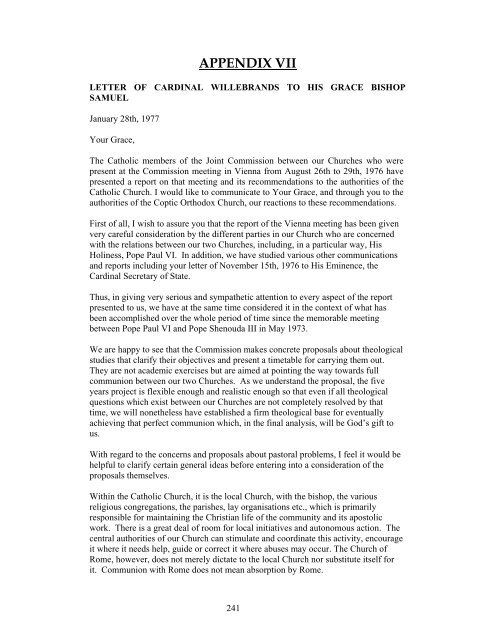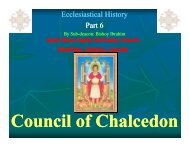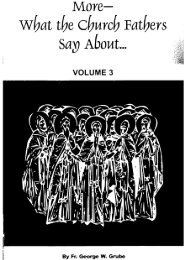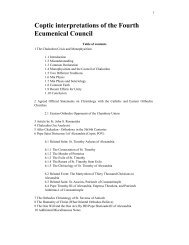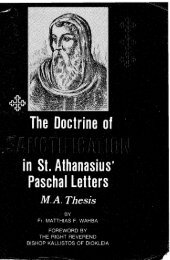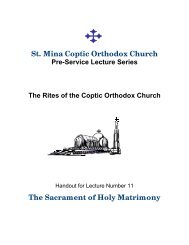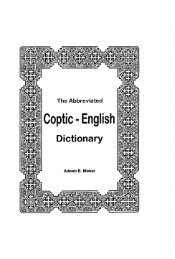Coptic Church & Ecumenical Movement - Saint Mina Coptic ...
Coptic Church & Ecumenical Movement - Saint Mina Coptic ...
Coptic Church & Ecumenical Movement - Saint Mina Coptic ...
Create successful ePaper yourself
Turn your PDF publications into a flip-book with our unique Google optimized e-Paper software.
APPENDIX VII<br />
LETTER OF CARDINAL WILLEBRANDS TO HIS GRACE BISHOP<br />
SAMUEL<br />
January 28th, 1977<br />
Your Grace,<br />
The Catholic members of the Joint Commission between our <strong>Church</strong>es who were<br />
present at the Commission meeting in Vienna from August 26th to 29th, 1976 have<br />
presented a report on that meeting and its recommendations to the authorities of the<br />
Catholic <strong>Church</strong>. I would like to communicate to Your Grace, and through you to the<br />
authorities of the <strong>Coptic</strong> Orthodox <strong>Church</strong>, our reactions to these recommendations.<br />
First of all, I wish to assure you that the report of the Vienna meeting has been given<br />
very careful consideration by the different parties in our <strong>Church</strong> who are concerned<br />
with the relations between our two <strong>Church</strong>es, including, in a particular way, His<br />
Holiness, Pope Paul VI. In addition, we have studied various other communications<br />
and reports including your letter of November 15th, 1976 to His Eminence, the<br />
Cardinal Secretary of State.<br />
Thus, in giving very serious and sympathetic attention to every aspect of the report<br />
presented to us, we have at the same time considered it in the context of what has<br />
been accomplished over the whole period of time since the memorable meeting<br />
between Pope Paul VI and Pope Shenouda III in May 1973.<br />
We are happy to see that the Commission makes concrete proposals about theological<br />
studies that clarify their objectives and present a timetable for carrying them out.<br />
They are not academic exercises but are aimed at pointing the way towards full<br />
communion between our two <strong>Church</strong>es. As we understand the proposal, the five<br />
years project is flexible enough and realistic enough so that even if all theological<br />
questions which exist between our <strong>Church</strong>es are not completely resolved by that<br />
time, we will nonetheless have established a firm theological base for eventually<br />
achieving that perfect communion which, in the final analysis, will be God’s gift to<br />
us.<br />
With regard to the concerns and proposals about pastoral problems, I feel it would be<br />
helpful to clarify certain general ideas before entering into a consideration of the<br />
proposals themselves.<br />
Within the Catholic <strong>Church</strong>, it is the local <strong>Church</strong>, with the bishop, the various<br />
religious congregations, the parishes, lay organisations etc., which is primarily<br />
responsible for maintaining the Christian life of the community and its apostolic<br />
work. There is a great deal of room for local initiatives and autonomous action. The<br />
central authorities of our <strong>Church</strong> can stimulate and coordinate this activity, encourage<br />
it where it needs help, guide or correct it where abuses may occur. The <strong>Church</strong> of<br />
Rome, however, does not merely dictate to the local <strong>Church</strong> nor substitute itself for<br />
it. Communion with Rome does not mean absorption by Rome.<br />
241


